Chapter 16
Ten Ways to Make Your Phone Totally Yours
IN THIS CHAPTER
![]() Getting the most out of your phone
Getting the most out of your phone
![]() Checking out the extra cool features that make this phone so good
Checking out the extra cool features that make this phone so good
![]() Making a personal statement
Making a personal statement
A smartphone is a very personal device. From the moment you take it out of the box and strip off the packaging, you begin to make it yours. By the end of the first day, even though millions of your type of phone may have been sold, there’s no other phone just like yours.
This is the case because of the phone calls you make and because of all the options you can set on the phone and all the information you can share over the web. Your contacts, music files, downloaded videos, texts, and favorites make your phone a unique representation of who you are and what’s important to you.
Even with all this “you” on your phone, this chapter covers ten or so ways to further customize your phone beyond what this book covers. Some of these suggestions involve accessories. Others involve settings and configurations. All are worth considering.
When it comes to accessories, your carrier’s retail store has many good options. And oodles, heaps, loads, and tons of options for your phone are available outside the carrier’s retail store. There is no need to limit yourself.
Using a Bluetooth Speaker
In just a matter of a couple of years, Bluetooth speakers have gone from an interesting (and expensive) option to mainstream. Prices have come down quickly, and the variety of designs for the speakers has grown dramatically. In all cases, you get the benefit of being able to play your music on your phone without the inconvenience of having headphones. You also get a speakerphone, although the quality of the audio can vary dramatically from Bluetooth speaker to Bluetooth speaker.
This accessory is best purchased in a brick-and-mortar store where you can listen to a variety of choices. Although syncing with a number of speaker choices can be tedious, it’s the only way you’ll know if a particular Bluetooth speaker meets your needs.
Although sound quality is essential, the folks in the industrial-design department have been having a lot of fun coming up with ways for the Bluetooth speaker to look. Figure 16-1 shows a range of options for the most popular form factors.

FIGURE 16-1: Popular Bluetooth speaker form factors.
The most popular options are basically a rectangle, the can style, and the sound bar. Each company has its own twist, but these options represent what you can see in the high-volume stores.
Fortunately, you live in a world where designers can get creative. The House of Marley, for example, uses unconventional design and recycled material to stand out in the market. Infinity Orb makes a levitating speaker. More than a few companies make Bluetooth speakers that look like the Death Star from Star Wars.
There is no shortage of imagination when it comes to Bluetooth. Be sure to consider all your options. Before you settle on the mainstream options at the local mall, do some research off the beaten path. You’ll be amazed at the range of options.
Cruising in the Car
You may have gotten the idea that I am concerned about your safety when you’re using your phone. True, but I’m also concerned with my safety when you’re using your phone. I would like you to have a Bluetooth speaker in your car when driving in my neighborhood, if you please.
Most new cars have a built-in Bluetooth system within the car stereo that connects to a microphone somewhere on the dash as well as to your car speakers. It’s smart enough to sense an incoming call and mutes your music in response.
If you don’t have such a setup, there are lots of good options for car speakers. Figure 16-2 shows an example.
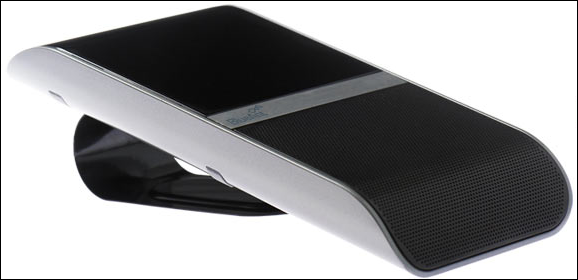
FIGURE 16-2: Bluetooth car speaker.
A closely related accessory is a car mount. A car mount will hold your phone in a place you can easily observe as you drive. The mount attaches to an air vent, the dashboard, or the windshield.
You could always put your phone on the seat next to you, but that’s for amateurs. Instead, offer your phone a place of honor with a car docking station. It makes accessing your phone while you drive safer and easier. Some see getting a car mount as a luxury, but my view is that if you need to upgrade your navigation software, you need a vehicle mount.
Figure 16-3 shows a typical vehicle mount. There are a great variety of options. Some mounts grip the phone, while other involve magnets. Some mounts use suction cups to hold onto the inside of your windshield, some clip on air vents, and still others you can screw into your dashboard. Many allow you to plug in a car charger, while others offer wireless charging. They cost $30 to $50. You can get these at your carrier’s store, at Best Buy, or at Amazon.

FIGURE 16-3: A standard vehicle mount.
More economical vehicle mounts are available that do not include a wireless charging pad. Figure 16-4 shows an example from SlipGrip that costs closer to $30.

FIGURE 16-4: A SlipGrip vehicle mount.
This version is special because it is specifically designed to work with larger protective cases. It can be a hassle to have to remove the protective case from your phone to insert it in a vehicle mount. In addition to a car mount, SlipGrip also offers a mount for your bicycle.
Considering Wireless Charging Mats
Those industrial designers have certainly gone crazy with Bluetooth speakers. They have also been having a field day on wireless charging options.
Most wireless charging mats are designed with the idea that you can place your phone on the mat, and technology will do the rest. The Samsung wireless charging pads, shown in Figure 16-5, go for between $35 and $50. These include Fast Charging capabilities, which will charge your phone from stone-cold dead to 100 percent in just a few hours.

FIGURE 16-5: Samsung wireless charging pads.
If these are too conventional for you, more options are out there as well. Figure 16-6 shows some of the more interesting options.
Look for more options going forward!
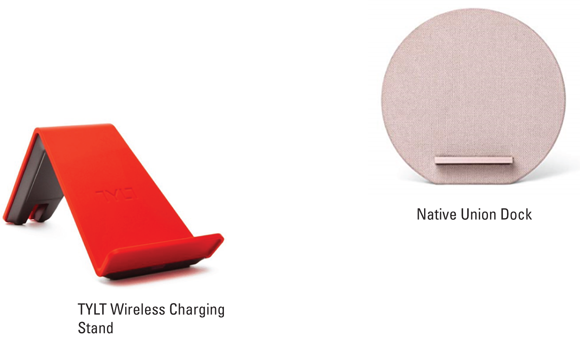
FIGURE 16-6: More exotic wireless charging pads.
Making a Statement with Wraps
Not the sandwich kind of wraps. I’m talking about the kind of wrap that lets you customize the non-glass portion of the S20.
The Samsung Galaxy S20 is very attractive, but you can spruce it up with an adhesive covering called a wrap from Skinit at www.skinit.com. These designs can express more of what is important to you. As a side benefit, they can protect your phone from minor scratches.
Figure 16-7 shows some design options for a skin. It comes with cut-outs for speakers, plugs, microphones, and cameras specifically for the Galaxy S20. Putting the skin on is similar to putting on a decal, although it has a little give in the material to make positioning easier. The skin material and adhesive are super high-tech and have enough give to allow klutzes like me (who struggle with placing regular decals) to fit the nooks and crannies of the phone like an expert.

FIGURE 16-7: Some sample wrap designs from Skinit.
If you’re not crazy about Skinit’s designs, you can make your own with images of your own choosing. Just be sure that you have the rights to use the images!
You Look Wonderful: Custom Screen Images
In addition to the shortcuts on your extended Home screen, you can also customize the images that are behind the screen. You can change the background to one of three options:
- Choose a neutral background image (similar to the backgrounds on many PCs) from the Wallpaper Gallery. Figure 16-8 shows a selection of background images that are standard on your phone.
- Any picture from your Gallery can be virtually stretched across the seven screens of your home page. (Read more about the Gallery in Chapter 9.)
- Opt for a theme that changes the background and fonts.

FIGURE 16-8: Standard wallpaper sample images.
The pictures from your Gallery and the Wallpaper Gallery are images that you can set by pressing and holding the Home screen. In a moment, you see icons appear. Select Wallpapers and pick the image you want. Many are free; others you can download for less than a dollar.
The themes take it to a different level. In addition to the background, the phone will change the fonts and many of the basic icons. You can select different themes, as shown in Figure 16-9, that follow different color and font combinations. There are lots of options.
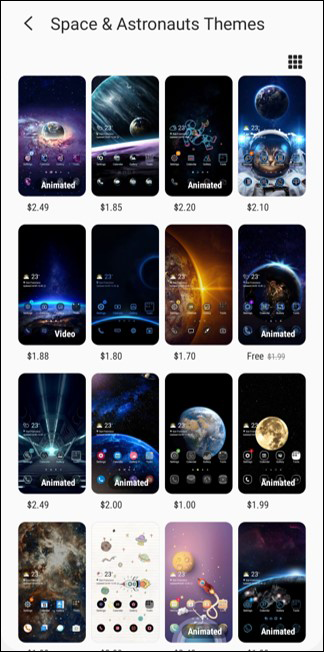
FIGURE 16-9: Different theme options.
A few samples also come on your phone. You may be a pink kind of person or a space nut. If these options aren’t to your taste, tap the Store link at the top of the page to see a range of options. If you do not see one you like today, be sure to check back as developers are adding new themes all the time. Do yourself a favor, and see if any of these strike a chord with you.
Empowering Power Savings
Imagine that you’re flying on a short hop from Smallville to Littleton. You are about to take off when air traffic control tells the pilot that the plane needs to wait on the tarmac. Unfortunately, you are low on battery. The pilot says that it is okay to use your mobile phone.
Because you do not know how long this will take, you pull out your phone, go to Settings, and tap Battery. From here, you put it in Power Savings Mode. This slows down a lot of cool features. For example, it dims the screen, slows the processors and mobile data speeds, and kills the vibration mode. This extends the battery life with minor sacrifices to what you can do with your phone. The apps all run, but perhaps not as fast.
Then the pilot says that your plane has a flat tire, the maintenance crew went home, and you could be sitting there for hours.
This time you open Settings, tap Device Care, tap Battery, tap Power Mode, and put your phone in Maximum Power Savings mode. Figure 16-10 shows the screen and then the pop-up to let you know what you’re getting yourself into.

FIGURE 16-10: Power Savings mode and pop-up.
Your beautiful, powerful smartphone has instantly turned itself into a dumb feature phone. You won’t be able to watch a full-length feature film. However, you now have enough battery to make and take phone calls and text messages for hours. This is not an exact science and your mileage may vary, but switching to this mode can multiply the time your smartphone can operate as a phone by eight to ten times. If you aren’t ready to return to the 2000s, you can use the Medium power savings mode.
Controlling Your Home Electronics
Traditional home appliances are getting smarter, offering more capabilities for better performance. One problem they have is that adding rows of control buttons (so that you can control those new capabilities) complicates manufacture. So, the next generation of appliances has begun to add a small LCD screen to the appliance. This can look slick, but it costs a lot and is prone to breakage. Also, the fancy capabilities involve pushing a confusing combination of buttons with cryptic messages displayed on a tiny screen.
The latest idea is to omit the screen altogether and give you control of the settings through an app on your smartphone. Your appliance retains the very basic buttons but allows you to use the fancy capabilities by setting them through your phone. You just download the free app made by the manufacturer from the Google Play Store, and you have your beautiful and logical user interface to control your new product — no strings attached.
For example, your new oven will allow you to turn it on and set the temperature without using a smartphone. However, if you want it to start preheating at 5:30 p.m. so that you can put the casserole in right when you walk in the door, you can set that up through your phone.
Wearing Wearables
Wearables are a class of mobile accessories that have been getting a lot of attention. For the most part, wearables are connected via Bluetooth and typically worn as a watch, although you can wear some sensors in athletic shoes. Samsung offers its wearables under the brand name Samsung Galaxy Watch (see Figure 16-11).
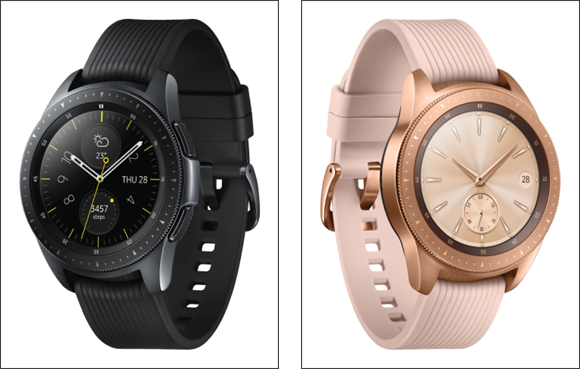
FIGURE 16-11: Samsung Galaxy Watch wearables.
In addition to telling the time, these wearables give you notifications, weather, and texts and track some relevant information, such as the amount of exercise you’ve done. These images look like conventional, but stylish analog watches. It shows you texts, a phone dialing pad, your altitude, and the useful information that would otherwise be shown on your phone. How cool is that?!
Using Your Phone as a PC
Your phone has all the computing power of a PC. Wouldn’t it be nice if you didn’t have to carry a laptop? Enter the Samsung Dex (see Figure 16-12).
The Dex Docking Cable may look like a charging cable, but it’s so much more. When you connect the little connector (USB-C) to your phone, you can connect the other end into a PC monitor or a TV. What’s on your beautiful small screen now appears on your beautiful big screen! If you connect a Bluetooth keyboard and mouse, it will almost seem like you have a regular PC. This is much smaller and more convenient than lugging around even the lightest laptop.
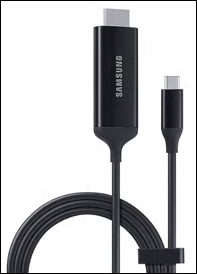
FIGURE 16-12: Samsung Dex Cable.
Creating Your Own AR Emoji
I’ve saved the best for last: You can take a self-portrait and make your own emoji that becomes an integral part of your Galaxy S20. You may be used to sending smiley faces, frown faces, and winks. Now you can send you.
Let me show you what I mean. Let’s say that you’re President Teddy Roosevelt, and you’re tired after a successful day of assaulting San Juan Hill, busting trusts, and rescuing orphan bear cubs. You sit down with your new Galaxy S20 smartphone, and decide to send a text to your pal Thomas Jefferson. (They were pals, right? They posed together for Mount Rushmore.) Instead of sending the conventional smiley face, you decide to send an AR Emoji. Figure 16-13 shows what you look like in real life and your smiling emoji.
When you create an emoji of yourself, this app creates a series of animations, called GIFs, that provide animation of your emoji showing a variety of emotions. These are stored in the Gallery app, and you can send them to anyone you like.
So, let’s say you’re happy because you just got word that they completed the Panama Canal. You send a happy emoji. You try, but fail, to institute a federal income tax, so you send a sad emoji. When you’re campaigning in Milwaukee, saloonkeeper John Schrank shoots you in the chest, but you keep on talking another 90 minutes. When you’re done speechifying, you’re quite cross with Mr. Shrank, so you send him an angry emoji. These emojis are shown in Figure 16-14. The complete library from the Gallery app is shown in Figure 16-15.

FIGURE 16-13: The real image and the emoji image.

FIGURE 16-14: Emoji options.
If you find your emoji to not quite capture you, you do have the ability to modify the image. You can add or take away hair, as well as adjust the color and style. You can also add glasses (although for some reason they don’t have the pince-nez glasses Teddy Roosevelt liked to wear). You can also change attire as needed.
When you’re an emoji in your phone, you and your phone are in it for the long haul!

FIGURE 16-15: Emoji options stored in your Gallery app.

 Be sure to put away the docking station when you park. Even an empty docking station is a lure for a thief.
Be sure to put away the docking station when you park. Even an empty docking station is a lure for a thief. When shopping for a car mount or a bike mount, be sure to consider the extra girth associated with a case. If you don’t use a case (which is a mistake), you just need to be sure that the mount is compatible with a Galaxy S20. If you have a case on your phone (which is anything but a mistake), be sure the mount will work with the Galaxy S20 and the case.
When shopping for a car mount or a bike mount, be sure to consider the extra girth associated with a case. If you don’t use a case (which is a mistake), you just need to be sure that the mount is compatible with a Galaxy S20. If you have a case on your phone (which is anything but a mistake), be sure the mount will work with the Galaxy S20 and the case.